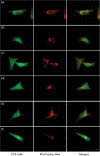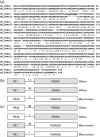Induction of cell death after localization to the host cell mitochondria by the Mycobacterium tuberculosis PE_PGRS33 protein
- PMID: 21081760
- PMCID: PMC7336528
- DOI: 10.1099/mic.0.041996-0
Induction of cell death after localization to the host cell mitochondria by the Mycobacterium tuberculosis PE_PGRS33 protein
Abstract
PE_PGRS33 is the most studied member of the unique PE family of mycobacterial proteins. These proteins are composed of a PE domain (Pro-Glu motif), a linker region and a PGRS domain (polymorphic GC-rich-repetitive sequence). Previous studies have shown that PE_PGRS33 is surface-exposed, constitutively expressed during growth and infection, involved in creating antigenic diversity, and able to induce death in transfected or infected eukaryotic cells. In this study, we showed that PE_PGRS33 co-localizes to the mitochondria of transfected cells, a phenomenon dependent on the linker region and the PGRS domain, but not the PE domain. Using different genetic fusions and chimeras, we also demonstrated a direct correlation between localization to the host mitochondria and the induction of cell death. Finally, although all constructs localizing to the mitochondria did induce apoptosis, only the wild-type PE_PGRS33 with its own PE domain also induced primary necrosis, indicating a potentially important role for the PE domain. Considering the importance of primary necrosis in Mycobacterium tuberculosis dissemination during natural infection, the PE_PGRS33 protein may play a crucial role in the pathogenesis of tuberculosis.
Figures







References
-
- Abarca-Rojano, E., Rosas-Medina, P., Zamudio-Cortéz, P., Mondragón-Flores, R. & Sánchez-Garcia, F. J Mycobacterium tuberculosis virulence correlates with mitochondrial cytochrome c release in infected macrophages. Scand J Immunol. 2003;58:419–427. - PubMed
-
- Abdallah A. M., Verboom T., Hannes F., Safi M., Strong M., Eisenberg D., Musters R. J., Vandenbroucke-Grauls C. M., Applemelk B. J., other authors A specific secretion system mediates PPE41 transport in pathogenic mycobacteria. Mol Microbiol. 2006;62:667–679. - PubMed
-
- Abdallah A. M., Gey van Pittius N. C., Champion P. A. D., Cox J., Luirink J., Vandenbroucke-Grauls C. M., Applemelk B. J., Bitter W. Type VII secretion – mycobacteria show the way. Nat Rev Microbiol. 2007;5:883–891. - PubMed
-
- Abdallah A. M., Verboom T., Weerdenburg E. M., Gey van Pittius N. C., Mahasha P. W., Jiménez C., Parra M., Cadieux N., Brennan M. J., other authors PPE and PE_PGRS proteins of Mycobacterium marinum are transported via the type VII secretion system ESX-5. Mol Microbiol. 2009;73:329–340. - PubMed
-
- Balaji K. N., Goyal G., Narayana Y., Srinivas M., Chaturvedi R., Mohammad S. Apoptosis triggered by Rv1818c, a PE family gene from Mycobacterium tuberculosis is regulated by mitochondrial intermediates in T cells. Microbes Infect. 2007;9:271–281. - PubMed
Publication types
MeSH terms
Substances
LinkOut - more resources
Full Text Sources
Miscellaneous

